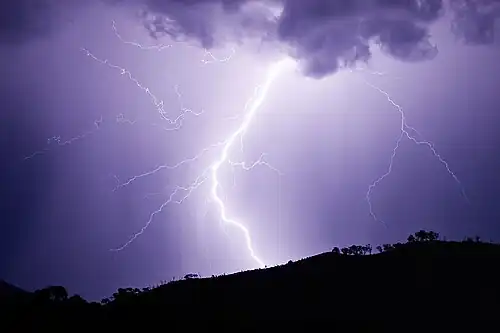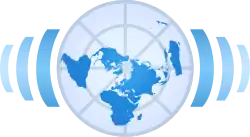Portal:Weather
The weather portal
Weather is the state of the atmosphere, describing for example the degree to which it is hot or cold, wet or dry, calm or stormy, clear or cloudy. On Earth, most weather phenomena occur in the lowest layer of the planet's atmosphere, the troposphere, just below the stratosphere. Weather refers to day-to-day temperature, precipitation, and other atmospheric conditions, whereas climate is the term for the averaging of atmospheric conditions over longer periods of time. When used without qualification, "weather" is generally understood to mean the weather of Earth.
Weather is driven by air pressure, temperature, and moisture differences between one place and another. These differences can occur due to the Sun's angle at any particular spot, which varies with latitude. The strong temperature contrast between polar and tropical air gives rise to the largest scale atmospheric circulations: the Hadley cell, the Ferrel cell, the polar cell, and the jet stream. Weather systems in the middle latitudes, such as extratropical cyclones, are caused by instabilities of the jet streamflow. Because Earth's axis is tilted relative to its orbital plane (called the ecliptic), sunlight is incident at different angles at different times of the year. On Earth's surface, temperatures usually range ±40 °C (−40 °F to 104 °F) annually. Over thousands of years, changes in Earth's orbit can affect the amount and distribution of solar energy received by Earth, thus influencing long-term climate and global climate change.
Surface temperature differences in turn cause pressure differences. Higher altitudes are cooler than lower altitudes, as most atmospheric heating is due to contact with the Earth's surface while radiative losses to space are mostly constant. Weather forecasting is the application of science and technology to predict the state of the atmosphere for a future time and a given location. Earth's weather system is a chaotic system; as a result, small changes to one part of the system can grow to have large effects on the system as a whole. Human attempts to control the weather have occurred throughout history, and there is evidence that human activities such as agriculture and industry have modified weather patterns.
Studying how the weather works on other planets has been helpful in understanding how weather works on Earth. A famous landmark in the Solar System, Jupiter's Great Red Spot, is an anticyclonic storm known to have existed for at least 300 years. However, the weather is not limited to planetary bodies. A star's corona is constantly being lost to space, creating what is essentially a very thin atmosphere throughout the Solar System. The movement of mass ejected from the Sun is known as the solar wind. (Full article...)
Selected article
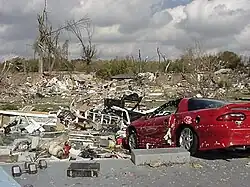
The Evansville Tornado of November 2005 was a powerful tornado that formed early in the morning of November 6, 2005, outside of Evansville, a city in Southwestern Indiana on the Ohio River. It was the first of several significant tornado events in the month of November 2005. The tornado resulted in 25 confirmed fatalities across the region, making it by far the deadliest and most destructive tornado in the United States in 2005, and it was also the deadliest single tornado in the US since 36 died in Oklahoma on May 3, 1999. Significant tornadoes were also reported in western Kentucky on the same day, but none were as damaging or deadly as the Evansville storm.
Recently selected articles: Typhoon Tip, Hurricane Floyd, Hurricane Dean, More...
Did you know (auto-generated) -

- ... that an attempted British-Norwegian attack on the German battleship Tirpitz was abandoned after two Chariot manned torpedoes were lost due to bad weather?
- ... that state representative Karl Bohnak, referring to his former profession, said that the Upper Peninsula of Michigan was one of the most challenging places in the U.S. to forecast the weather?
- ... that MyRadar uses a custom satellite constellation to help forecast the weather?
- ... that Richard Davis made the earliest known continuous land-based weather recordings in New Zealand?
- ... that Come In was recorded on a hands-free microphone attached to a pair of headphones?
- ... that the weather forecast for HD 189733 b is "Westerly winds at 2000 m/s, with molten glass showers"?
Selected image
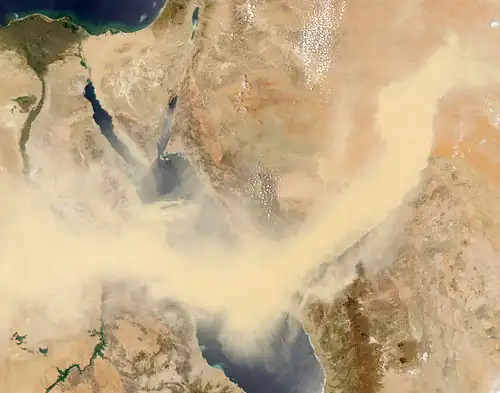
A dust storm is a meteorological phenomenon where strong winds lift loose dust from arid and semi-arid regions, often transporting the particles long distances. These storms can continue hundreds of miles from their source, and can have drastic effects on human health, transportation, and society in general. This storm occurred in May 2005 over the Red Sea.
Recently selected pictures: Parallax, Global snow cover, Snow flakes, More...
More did you know...
...that the Flying river is the name given to the transport of water vapor from the Amazon rainforest to southern Brazil?
...that hurricane shutters are required for all homes in Florida unless impact-resistant glass is used?
...that the Joint Institute for Marine and Atmospheric Research is a combined weather and ocean research institute with the cooperation of the Office of Oceanic and Atmospheric Research and the University of Hawaiʻi?
...that the SS Central America was sunk by a hurricane while carrying more than 30,000 pounds (13,600 kg) of gold, contributing to the Panic of 1857?
...that a hurricane force wind warning is issued by the United States National Weather Service for storms that are not tropical cyclones but are expected to produce hurricane-force winds (65 knots (75 mph; 120 km/h) or higher)?
...that the Automated Tropical Cyclone Forecasting System is a software package for tropical cyclone forecasting developed in 1988 that is still used today by meteorologists in various branches of the US Government?
Recent and ongoing weather
- Wikinews weather portal
- March 26, 2021: Tropical moisture ceases to cause severe floods in South East Australia
- February 19, 2021: Winter storms hammer Texas, fatalities reported
- December 28, 2021: Typhoon Phanfone strikes Philippines
- February 1, 2022: Deadly floods in Brazil after heavy rainfall
- April 15, 2022: South African floods kill at least 300 people
- Weather of 2025
- 2025 Atlantic hurricane season
- 2020–21 North American winter
- 2025 Pacific typhoon season
- Tornadoes of 2025
This week in weather history...
August 18
2008: The Indian state of Bihar experienced an historic flood when the Kosi River changed its course, affecting more than 2 million people and killing hundreds.
August 19
1838: Hugo Hildebrand Hildebrandsson, a Swedish meteorologist who compiled the first International Cloud Atlas, was born in Stockholm.
August 20
1970: The 8th deadliest tornado in Canadian history struck Sudbury, Ontario.
August 21
1883: A tornado struck Rochester, Minnesota, killing 37. The destruction led to the founding of the Mayo Clinic.
August 22
1999: China Airlines Flight 642 crashed while attempting to land at Hong Kong International Airport during Typhoon Sam, killing 3 passengers.
August 23
1873: The first known hurricane warning in history was raised for portions of the eastern United States, for a hurricane that would eventually strike Newfoundland. This warning was issued by Father Benito Vines, director of the Meteorological Observatory of the Royal College of Belén in Havana, Cuba.
August 24
2006: A tornado outbreak struck the northern Great Plains, including an EF3 tornado that killed one person in Kasota, Minnesota.
Selected biography
Edward Norton Lorenz (May 23, 1917 – April 16, 2008) was an American mathematician and meteorologist who established the theoretical basis of weather and climate predictability, as well as the basis for computer-aided atmospheric physics and meteorology. He founded modern chaos theory, a branch of mathematics focusing on the behavior of dynamical systems that are highly sensitive to initial conditions.
His discovery of deterministic chaos "profoundly influenced a wide range of basic sciences and brought about one of the most dramatic changes in mankind's view of nature since Sir Isaac Newton," according to the committee that awarded him the 1991 Kyoto Prize for basic sciences in the field of earth and planetary sciences. (Full article...)
Previously selected biographies: Vilhelm Friman Koren Bjerknes; Anders Celsius, More...
Related portals
Quality content




Cirrus clouds
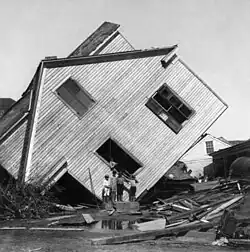
1900 Galveston Hurricane
![]()
Cumulus clouds

Cirrus clouds
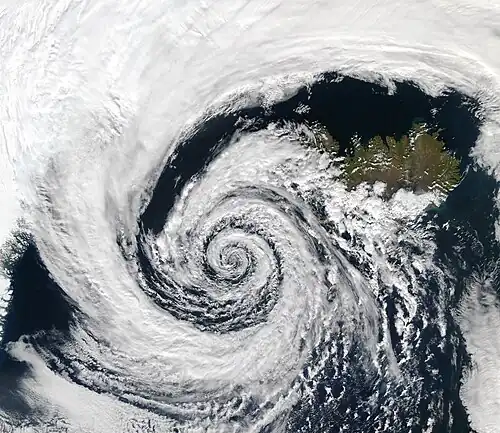
Low pressure area
More weather-related Featured Pictures...

- Retired Pacific hurricanes
- Hurricane Dean
- Hurricane Isabel
- 1998 Pacific hurricane season
- Hurricane Dean
- Retired Pacific hurricanes
- 2003 Atlantic hurricane season
- More weather-related Featured Topics...

Feat. article candidates:
- Tropical Storm Ileana (2018) (Discussion)
Featured list candidates:
Feat. picture candidates:
Other candidates:
- Featured Article Review: 2005 Atlantic hurricane season (Discussion)
- Featured List Removal Candidate: List of storms in the 2005 Atlantic hurricane season (Discussion)

Subcategories

WikiProjects
The scope of WikiProject Weather is to have a single location for all weather-related articles on Wikipedia.
WikiProject Meteorology is a collaborative effort by dozens of Wikipedians to improve the quality of meteorology- and weather-related articles. If you would like to help, visit the project talk page, and see what needs doing.
WikiProject Severe weather is a similar project specific to articles about severe weather. Their talk page is located here.
WikiProject Tropical cyclones is a daughter project of WikiProject meteorology. The dozens of semi-active members and several full-time members focus on improving Wikipedia's coverage of tropical cyclones.
WikiProject Non-tropical storms is a collaborative project to improve articles related to winter storms, wind storms, and extratropical cyclones.
Wikipedia is a fully collaborative effort by volunteers. So if you see something you think you can improve, be bold and get to editing! We appreciate any help you can provide!
Associated Wikimedia
The following Wikimedia Foundation sister projects provide more on this subject:
-
Commons
Free media repository -
Wikibooks
Free textbooks and manuals -
Wikidata
Free knowledge base -
Wikinews
Free-content news -
Wikiquote
Collection of quotations -
Wikisource
Free-content library -
Wikiversity
Free learning tools -
Wiktionary
Dictionary and thesaurus
Other Portals
-
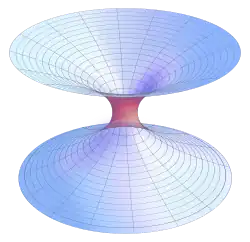 List of all portals
List of all portals -

-

-

-
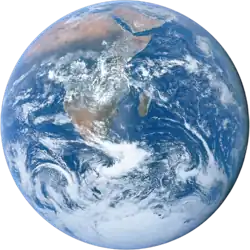
-

-

-

-

-

-
 Random portal
Random portal -
 WikiProject Portals
WikiProject Portals
What you can do
 |
Here are some tasks awaiting attention:
|
.jpg)
